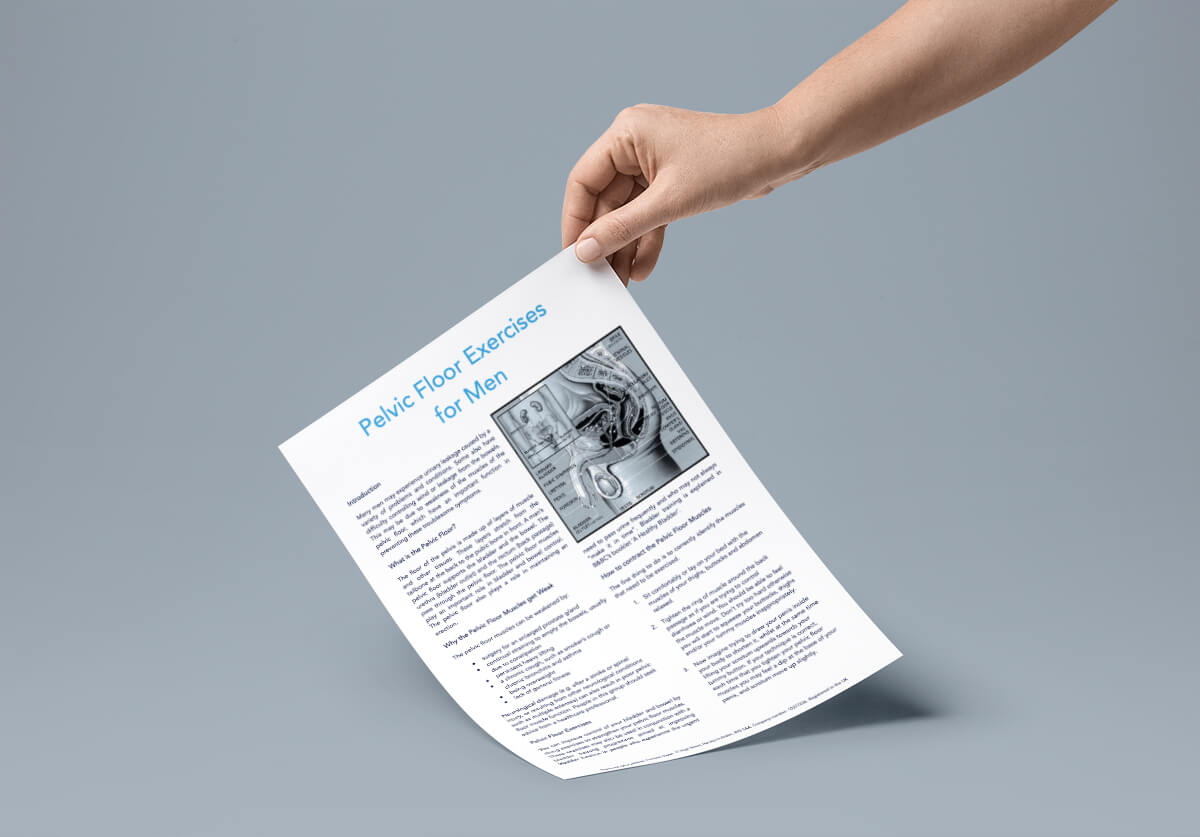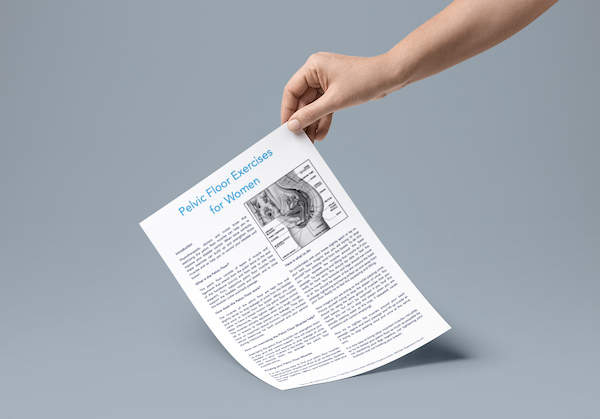The key to treating bowel incontinence – also known as faecal incontinence – is to find the condition that is causing this. Chronic constipation and a weak pelvic floor are two of the most common causes of faecal incontinence and in many cases this can be resolved through a change of diet, regulating the bowel with the help of training, pelvic floor exercises and avoiding constipation.
If constipation isn’t the cause, there are still many ways of treating bowel incontinence and you should seek help from your GP, who will be able to advise of the best route for you.
CONSERVATIVE TREATMENTS
Treatment for bowel incontinence or faecal incontinence can be as simple as making some lifestyle changes, such as adjusting your diet and exercise habits, taking up pelvic floor exercises, or bowel retraining. These are all home remedies that can help reduce symptoms of bowel incontinence.
Lifestyle and Diet Changes
It may be useful to keep a food diary and write down whether your symptoms are more severe or less severe with certain food. You can then start to cut down or eliminate those foods that are causing gastrointestinal upset. Similarly it is also worth experimenting to see whether your symptoms improve by eating little and often rather than three large meals a day. You may find that you can manage your condition effectively just by changing what and how you eat. Click to find out more about diet and lifestyle.
Pelvic Floor Muscle Exercises
The pelvic floor is layers of muscles that stretch from the pubic bone to the coccyx and then from side to side. These muscles help to support the bladder and bowel plus the womb in women. These muscles can become weak through trauma such as childbirth or surgery, changing hormones, persistent coughing or chronic constipation. When these muscles become slack it can weaken the sphincter muscle to the rectum allowing the involuntary passing of stool. Click to read more about pelvic floor muscle exercises.
This is just as important for men as it is for women – you can download the most appropriate guide for you below.
Pelvic Floor Exercises For Men
[BBC:030] Pelvic Floor Exercises For Men
Training your pelvic floor muscles can help improve your bowel control and this is as important for men as it is for women. This guide explains how to perform pelvic floor exercises.
Pelvic Floor Exercises For Women
[BBC:031] Pelvic Floor Exercises For Women
Training your pelvic floor muscles can help improve your bowel control. This guide explains how to perform pelvic floor exercises, specifically for women, to help treat bowel incontinence.
Bowel Retraining
Bowel retraining involves establishing your bowel into a regular routine and retraining your brain to hold on. You start by going to the bathroom when you get the urge to go and hold for 1 minute before sitting down. Gradually increase the length of time until you feel more confident with your control. It is also helpful to completely empty your bowel once a day at the same in order to train your bowel into a pattern. Make sure that this is a time that is comfortable and allow you enough time so that you don’t feel anxious. Some people also like to record a bowel diary to see if any foods that contribute to your bowel condition.
Biofeedback
Biofeedback is a type of bowel training exercise. It involves placing a small electric probe into the rectum and a sensor will measure movement and pressure from the sphincter muscles. You will be asked to squeeze your sphincter muscles and the probe will measure the response. This information will be able to guide you whether you are able to learn to squeeze effectively to retain bowel control.
Tibial Nerve Stimulation
Percutaneous Nerve Stimulation or PTNS as it is commonly known is a treatment that directly stimulates the nerves responsible for bowel control and is a method that can be used to bowel incontinence (faecal incontinence). To find out more about Tibial Nerve Stimulation click here.
MEDICINAL
Antimotility Medication
Anti-motility/ antidiarrhoeals such as loperamide, more commonly known as Imodium can be purchased over-the-counter. They work by slowing the gut transit making your stools firmer and pass less frequently as a treatment for bowel incontinence. It is important not to use this medication is you have diarrhoea with blood and/or mucus or have a temperature. Some people find that this type of medication increases pain and bloating in the stomach.
Laxatives
Faecal incontinence can be caused by overflow from constipation and impaction. To combat this you may be initially prescribed a bulking agent such a Fybogel to soften the stool and bulk up the contents making it easier to pass. These may help to regulate bowel movement. If a bulking agent doesn’t help then your GP may be able to advise on an alternate laxative to use.
Enemas/ Rectal Irrigation
Rectal irrigation is also known as anal irrigation or trans-anal irrigation is a method that involves emptying the bowel by ‘washing it out’ using a specialised pump, water and irrigation tube. This is an effective treatment in the management of chronic constipation and faecal incontinence.
Enemas can be used to clear impaction from severe constipation and involves administering a solution such as water and sodium phosphate to clear the bowel.
Injectable Treatments
Injectable therapies are a less invasive treatment option to surgery if conservative methods have failed to improve the condition. This involves injecting a gel into the anal canal to bulk up the tissues and prevent leakage and improve bowel control.
SURGICAL
Sacral Nerve Stimulation
Sacral Nerve Stimulation (SNS) or Sacral Neuromodulation (SNM) is a device that is implanted under the skin in the upper buttock. It helps by correcting the messages that run along our nerve pathways. SNM is performed in two stages, first you will undergo an evaluation, and then, depending on your results you will be offered the implant. Find out how Sacral Nerve Stimulation works by clicking here.
Anterior Anal Sphincter Repair
This surgery involves a cut being made in front of the sphincter and the muscles are then overlapped and stitched back in place. This surgery isn’t advised for any women who are considering having further children as this could put pressure on the repaired sphincter. Click to find out more about an anterior anal sphincter repair.
Colostomy
A colostomy involves making a small incision in the abdomen and then pulling through a section of your colon to the surface and sewn to your abdomen, creating an artificial opening called a stoma. Your stool will then be collected in a small pouch that attaches to your stoma. Colostomies can be temporary or made permanent. They are usually a last resort surgery if all other methods have not been successful.
ALTERNATIVE
Acupuncture
Acupuncture is an alternative therapy with ancient origins that dates back to nearly 2,000 years ago. In this health practice it is believed that illness and pain happen when the body’s qi or energy flow becomes blocked. Acupuncture uses fine sterile needles and inserts them into specific points in the body to release the body’s energy flow, thus restoring balance to the body. A study in 2009 found that targeting specific points in the abdomen, spine and leg has shown to improve bowel and sphincter control.
Further information and downloads can be found in the RESOURCES section. Living with a bowel condition can affect you emotionally and socially; sometimes it can help to speak to others who understand your situation. The Bladder & Bowel Community Support Group is available 24 hours today and will allow you to connect with those who share your condition. Start your own topic today or just follow one that interests you.










